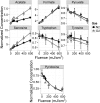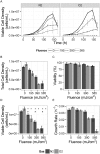Impact of Dissolved Oxygen during UV-Irradiation on the Chemical Composition and Function of CHO Cell Culture Media
- PMID: 26975046
- PMCID: PMC4790850
- DOI: 10.1371/journal.pone.0150957
Impact of Dissolved Oxygen during UV-Irradiation on the Chemical Composition and Function of CHO Cell Culture Media
Abstract
Ultraviolet (UV) irradiation is advantageous as a sterilization technique in the biopharmaceutical industry since it is capable of targeting non-enveloped viruses that are typically challenging to destroy, as well as smaller viruses that can be difficult to remove via conventional separation techniques. In this work, we investigated the influence of oxygen in the media during UV irradiation and characterized the effect on chemical composition using NMR and LC-MS, as well as the ability of the irradiated media to support cell culture. Chemically defined Chinese hamster ovary cell growth media was irradiated at high fluences in a continuous-flow UV reactor. UV-irradiation caused the depletion of pyridoxamine, pyridoxine, pyruvate, riboflavin, tryptophan, and tyrosine; and accumulation of acetate, formate, kynurenine, lumichrome, and sarcosine. Pyridoxamine was the only compound to undergo complete degradation within the fluences considered; complete depletion of pyridoxamine was observed at 200 mJ/cm2. Although in both oxygen- and nitrogen-saturated media, the cell culture performance was affected at fluences above 200 mJ/cm2, there was less of an impact on cell culture performance in the nitrogen-saturated media. Based on these results, minimization of oxygen in cell culture media prior to UV treatment is recommended to minimize the negative impact on sensitive media.
Conflict of interest statement
Figures






Similar articles
-
Treating cell culture media with UV irradiation against adventitious agents: minimal impact on CHO performance.Biotechnol Prog. 2014 Sep-Oct;30(5):1190-5. doi: 10.1002/btpr.1942. Epub 2014 Jul 29. Biotechnol Prog. 2014. PMID: 25044686
-
Cellular attachment and spatial control of cells using micro-patterned ultra-violet/ozone treatment in serum enriched media.Biomaterials. 2004 Aug;25(18):4079-86. doi: 10.1016/j.biomaterials.2003.11.010. Biomaterials. 2004. PMID: 15046899
-
Chemically defined media modifications to lower tryptophan oxidation of biopharmaceuticals.Biotechnol Prog. 2016 Jan-Feb;32(1):178-88. doi: 10.1002/btpr.2195. Epub 2015 Dec 7. Biotechnol Prog. 2016. PMID: 26560440
-
Review: High temperature short time treatment of cell culture media and feed solutions to mitigate adventitious viral contamination in the biopharmaceutical industry.Biotechnol Prog. 2021 May;37(3):e3117. doi: 10.1002/btpr.3117. Epub 2021 Jan 9. Biotechnol Prog. 2021. PMID: 33372404 Review.
-
[Postreplicative DNA repair in UV-sensitive Chinese hamster cell clones].Tsitologiia. 1980 Sep;22(9):1085-95. Tsitologiia. 1980. PMID: 7003862 Review. Russian.
Cited by
-
Evaluating ultraviolet sensitivity of adventitious agents in biopharmaceutical manufacturing.J Ind Microbiol Biotechnol. 2017 Jun;44(6):893-909. doi: 10.1007/s10295-017-1917-0. Epub 2017 Mar 10. J Ind Microbiol Biotechnol. 2017. PMID: 28283956 Free PMC article. Review.
-
Design of Novel Tricaprylin-Incorporated Multi-Layered Liposomal System for Skin Delivery of Ascorbic Acid with Improved Chemical Stability.Pharmaceuticals (Basel). 2023 Jan 13;16(1):121. doi: 10.3390/ph16010121. Pharmaceuticals (Basel). 2023. PMID: 36678619 Free PMC article.
-
Portable Analytical Techniques for Monitoring Volatile Organic Chemicals in Biomanufacturing Processes: Recent Advances and Limitations.Front Chem. 2020 Sep 11;8:837. doi: 10.3389/fchem.2020.00837. eCollection 2020. Front Chem. 2020. PMID: 33024746 Free PMC article. Review.
References
-
- Aranha H. Virus safety of biopharmaceuticals: Absence of evidence is not evidence of absence. Contract Pharma. 2011;13: 82–87.
Publication types
MeSH terms
Substances
LinkOut - more resources
Full Text Sources
Other Literature Sources

